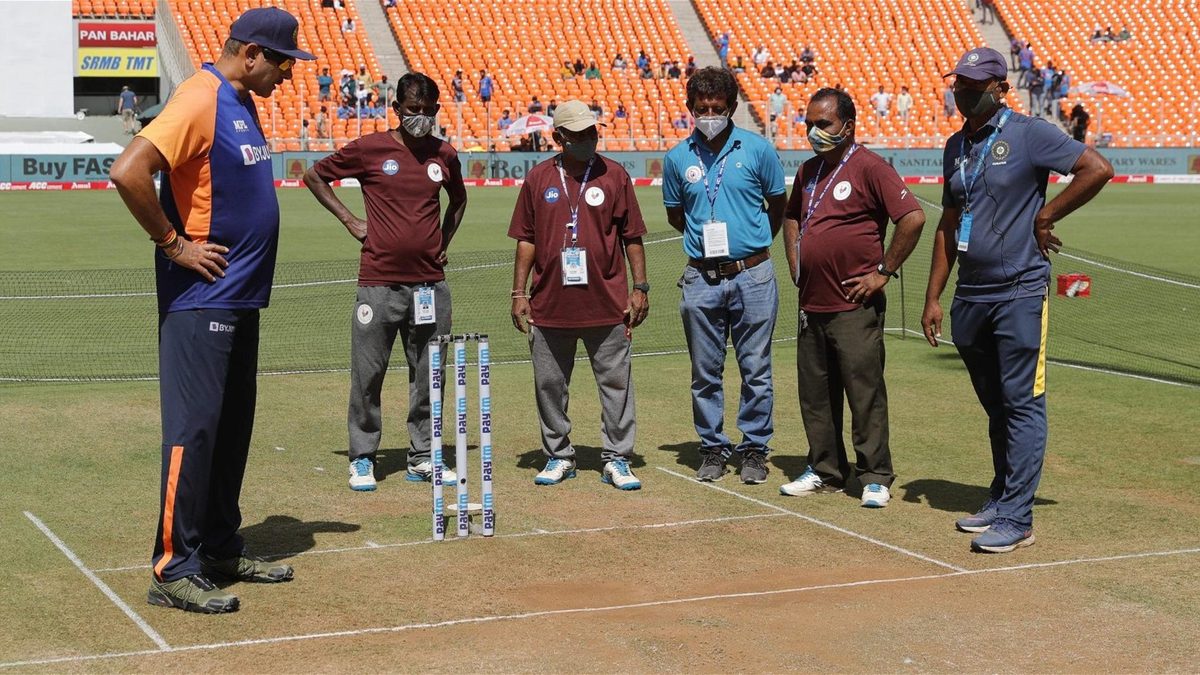
Ben Gardner asks whether England might have reason to be hopeful they will find a pitch more to their liking in the fourth Test.
There has been much, much consternation and discussion over the state of the pitch used for the third India-England Test, the first to be played at the Narendra Modi Stadium. All but two wickets in the game fell to spin, with England captain Joe Root, a part-timer, claiming figures of 5-8 in the first session of day two.
The reaction has been divided, with India’s players attempting to quell any criticism – captain Virat Kohli described it as a “very good pitch to bat on” – even as England weigh up making a formal complaint to match referee Javagal Srinath. Large-scope debates have taken place over what such surfaces mean for the fabric of Test cricket, whether a spin-friendly surface is any different, in principle, to a seaming one, and what the nature of home advantage should be.
Less discussed are the immediate implications for the series, which still has one game left to play out, with England still theoretically in with a chance of securing a hugely creditable 2-2 draw. Given their struggles against the turning ball recently, a comeback might seem like a long shot. Since racking up nearly 600 in the first innings of the first Test, they have now been bowled out for less than 200 five times in succession, the first time that has happened to England since 1888. Only Root has averaged even 30 with the bat, with the rest of the line-up looking, at times, hopelessly incapable of dealing with the demands of playing spin on a helpful surface.
However, it’s the very nature of the pitch for the third Test which should give England hope that the fourth could be different. There is, as yet, no judgement available on the pitch rating; these tend to be revealed after a series’ conclusion, and are only sent to a home board 14 days after a match has ended. There seems at least a chance the surface for the third Test will receive a ‘poor’ rating, with it arguable that it showed “excessive assistance to spin bowlers, especially early in the match”, one of the criteria in the ICC’s Pitch and Outfield Monitoring Process.
If such a decision is reached, the venue will receive three demerit points. Should it receive two more, it would be banned from hosting international cricket for 12 months. In a normal year, that would be an irritation, but India is a country flush with handsome venues. However, in 2021 it would be disastrous, with a T20 World Cup set for November, and the brand new 132,000 seater in line to host the final.
While it would take a brave adjudicator to effectively sin bin the jewel in the BCCI’s crown two games into its existence, pressure from the ECB, as well as professional pride, could be enough to force a fair judgement. India might be confident that the rulings will fall in their favour. But can they be sure?
Losing out on that opportunity would be genuinely damaging to Indian cricket, and so the BCCI’s priority may well become avoiding a potential ‘poor’ rating in the final Test, even if that lessens the chances of a series win. Though they only need a draw in the final Test to secure not only the series but also a place in the World Test Championship final, the option of preparing a road should also be unappealing. A pitch can also be rated poor if it “displays little or no seam movement or turn at any stage in the match together with no significant bounce or carry, thereby depriving the bowlers of a fair contest between bat and ball”.
All they may be left with is attempting to prepare a pitch like that seen for the first game, which started out batting friendly while getting progressively worse. It’s on exactly that type of pitch that England have thrived this winter, with huge hundreds from Root propping up big totals in both Tests in Sri Lanka and the first Test in India.
Those results seem to have spooked India, who, before this series, have gone away from relying on spinning tracks to win at home. After the first game, India reportedly removed the pitch curator, overseeing the upkeep of the second Test surface themselves. Now, if they are to make sure they avoid an embarrassing stadium ban in a huge year for Indian cricket, they may have no choice but to request a surface which England have proven themselves on. Root may be a mere coin flip away from another big ton and a heroic series result.








